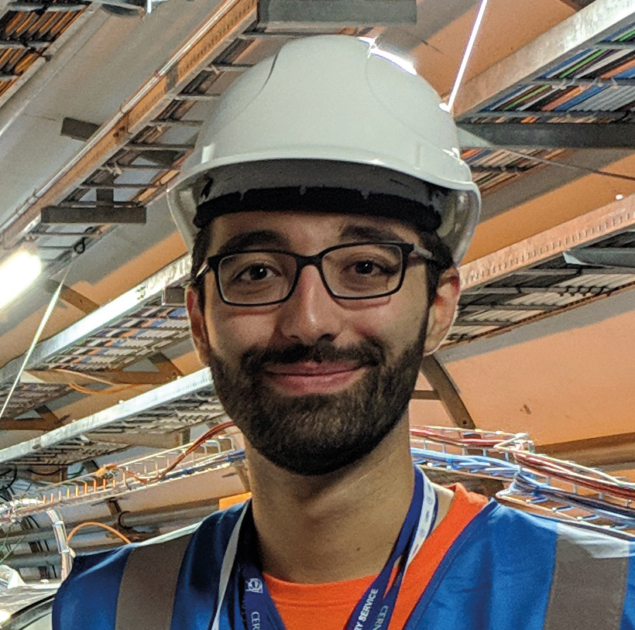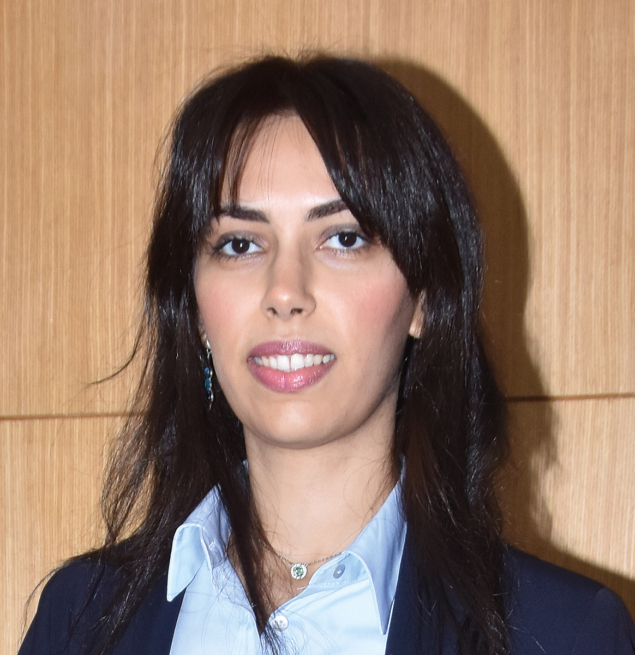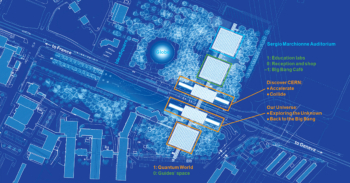CERN members of personnel who dedicate part of their time to taking visitors on tours share their many memorable experiences.
Tobias Patrick Treczoks

Guide since: October 2022
Position: Masters student for VITO at ISOLDE (User, University of Oldenburg)
Languages: German, English
One thing that makes being a CERN guide so interesting and exciting is the diversity of our visitors. You might have a super-interested 10 year-old, for whom the visit to CERN is his birthday present, or you could find yourself discussing the connection between Buddhism and the Higgs boson with a monk.
One visit that I remember vividly was with a group of Swiss–German retirees. All of the visitors were hard of hearing, with the majority of them being deaf. To facilitate communication they brought two sign-language translators with them. Before the start of the tour some of the visitors were concerned that their cochlear implants, which can restore some hearing, might be influenced by CERN’s equipment. Luckily, I studied medical physics and audiology before coming to CERN, so I was able to reassure them that everything will be fine. On that day we were showing the group the Synchrocyclotron and the ATLAS Visitor Centre. Communicating via the translators was something that was completely new for me, as I am sure terms such as muon spectrometer or superconducting magnet were to them. Due to the translation, it naturally took a few seconds longer than usual to see the audience’s reaction. In most cases, however, it was full of excitement and often more effusive than with a group of hearing visitors. Many questions were asked and a lot of photos were taken, later to be shown to their grandchildren.
Although the tour took much longer than planned, I do not regret a single second I got to spend with them. When the group finally left CERN, there was not only a bright smile on their faces but on mine as well. Engaging people in our research and making it accessible to everybody regardless of their background, age or impairments is something which to me is a vital part of CERN’s mission.
Imtiaz Ahmed

Guide since: 2013
Position: Electronics engineer at CMS (User, NCIP Estonia)
Languages: English
I’ve been guiding for nearly a decade, and during this time have had plenty of exciting tours. When I first started, I helped my supervisor as a translator. I joined her at the virtual CMS visits for Pakistani prisoners in a jail in Athens.
For in-person tours I like to take visitors to the Synchrocyclotron, ATLAS Visitor Centre, CERN Control Centre, SM18 (currently under renovation) and CMS. There they get a good overview of how accelerators and detectors work. One of the typical questions I get is about the power consumption of CERN.
Weekends are busy times. The visitors are always curious and come with many questions. Besides power consumption, they want to know about quantum computers, how data gets stored and handled, and the technologies that are used for electronics, vacuum, magnets and cryogenic cooling. Of course, the Higgs boson as well as future goals are always of interest, too. As we give guided tours in radiation surveillance areas, people also have questions about safety risks.
I like guiding very much. It is very rewarding to represent CERN in this way, especially when the visitors appreciate it with their compliments and applauds. The loveliest I heard was when a girl told me that she had taken a tour with me a few years before and that it had motivated her to become a CERN technical student.
David Amorim

Guide since: 2017
Position: Senior fellow for the Muon Collider study
Languages: French, English
In 2008, I had the great opportunity to undertake a one-week middle-school internship at CERN, during which I discovered the contagious passion for science and technology I saw in my supervisors. Today, it’s my turn to try and pass on that passion to everyone, especially young people.
Whether it’s showing visitors around the most iconic places at CERN or at events such as Science Night, I’ve been able to meet and talk to people of all ages and backgrounds. Many visitors initially feel that what is done at CERN and in physics research in general is too difficult to understand. However, after a few discussions and by making connections with everyday phenomena or objects, people become interested and grasp the value of such research, and often want to find out more or come back to CERN.
I also particularly enjoy guiding school classes and taking part in activities aimed at children. Whether it’s working with schools when their classes come to visit us, or taking part in science shows such as “Fun with Physics”, I always see a sense of wonder and a “wow” effect, not just in the children’s eyes but also those of the teachers and adults who accompany them.
Children are curious about everything and ask lots of questions about the world around them and how we study it. This requires that we, as guides, question ourselves and stay curious, because some questions, such as “How does the Higgs boson work?” are not easy to answer. This offers an opportunity to involve everyone: the group of children act as the Higgs field, their parents or teachers then try to make their way through while the kids can gently heckle the adults, giving the “particles” mass. Together they reconstruct the Higgs mechanism!
Being a guide at CERN brings a dimension to one’s work that I think is necessary to our profession: that of sparking curiosity. For example, I remember a 12-year-old girl from nearby Meyrin who told me that she wanted to understand the world around us by becoming a physicist and then go into politics to better protect it.
Hassnae El Jarrari

Guide since: October 2021
Position: CERN Research Fellow in Experimental Physics
Languages: English, French, Arabic
I became a CERN guide because I wanted to expand my knowledge beyond my research topic and to explore other experimental sites. Little did I know how much excitement and challenges await me each time I lead a group of visitors.
At CERN, the diverse range of visitors creates a unique cultural experience as people come from different backgrounds and with varying scientific interests. They are often curious to verify information they have heard about CERN in the media and elsewhere. However, language barriers can occasionally lead to amusing situations. For example, I once had a group of visitors who spoke neither English nor French, so I had to use my imagination to create a universal scientific language to guide them through the Synchrocyclotron and ATLAS Visitor Centre facilities.
Throughout my time as a CERN guide, I have had many unforgettable moments that have only deepened my appreciation for the work that we do. One experience that stands out is when I had the pleasure of meeting a five-year-old boy and his parents who were visiting for his birthday. Despite his young age, this child had an impressive understanding of particle physics and the activities taking place at CERN. I couldn’t help but wonder if he was one of those rare geniuses who start university at a young age. To my surprise, his parents informed me that they don’t have any physics books at home and that his knowledge has solely come from the internet. His enthusiasm for the subject was truly inspiring and I couldn’t help but think that I may have been in the presence of a future physicist.
Another vivid memory was when an American father approached me after his visit and asked if I could help him get in touch with his high-school daughter in the US. She was interested in physics but lacked a female role model to explore and pursue her passion. We are still exchanging emails whenever she needs guidance or information. Her father has even promised to bring her to CERN at the first opportunity.
I was also part of the ATLAS virtual visits and initiated a programme dedicated to Moroccan universities and high schools. These virtual visits proved to be an effective means of promoting not only the ATLAS experiment but also CERN’s overall activities to a wider audience, resulting in an increased number of Moroccan students and visitors at CERN.
Noemi Calace

Guide since: 2014
Position: ATLAS physicist (staff)
Languages: English, Italian, French
I have the honour of wearing two hats: that of a scientist and a guide. As a CERN physicist, I have long believed that one of my core missions is to contribute to raise awareness about the different activities and research projects carried out at CERN. By doing so, we dispel fear and create opportunities to educate people about the significance of scientific research.
Guiding young students, especially those from high school, is where my heart finds joy. When students interact with scientists at CERN, they often feel intimidated, perceiving them as superhuman figures. However, as their guide, I consistently receive comments expressing relief and surprise when they realise that scientists are just ordinary individuals like themselves. This relief often sparks a sense of confidence, which makes them realise that pursuing a career in science is within their reach – often at a crucial juncture in their education, having to decide which field of study to pursue. My impact may be just one jigsaw piece in their decision, yet, in some sense, I feel a certain level of responsibility for their future choices.
One heartfelt tale involved a girl who expressed her fear of pursuing research, believing it to be a field dominated by men. I told her stories of incredible women who have made significant contributions to science, and I shared with her my own experience: woman, mother, physicist. I saw her eyes glimmer with a fresh sense of hope and determination. Imagine my overwhelming joy when a few years later I received an email from her, revealing that she had started university in a scientific field and had a strong desire to pursue a PhD. She expressed how our conversation had ignited a fire within her, dispelling her doubts and fuelling her ambition.
These rich and fulfilling experiences as a guide at CERN not only underscore the significance of outreach but also serve as a rewarding testament to the impact of our efforts in nurturing young minds.
Dominique Bertola

Guide since: 1999
Position: Visits service operations manager (staff)
Languages: French, English
In 2015 I was contacted by the president of a local association, Les Enfants de la lune (“Moon children”), which helps families and children who suffer from a rare but serious and restrictive disease that forbids them from exposure to ultraviolet (UV) radiation under risk of developing skin or eye cancer. The president wanted to organise a visit to CERN to show them science in a fun way if possible. I immediately responded, taking care to check with the medical service and colleagues from HSE that the site we were visiting offered no or very little UV light, and measuring UV levels in the main auditorium. Together with the visits service we were able to invite about 40 children accompanied by adults to the afternoon event. They arrived by bus, with windows protected by an anti-UV film, equipped with anti-UV suits, resembling astronaut masks and gloves. As soon as they disembarked, they were accompanied to the auditorium in which they were able to remove their suits and helmets in complete safety. I performed several demonstrations that delighted the youngest visitors (from age five) and their parents alike – especially when they were able to taste a few marshmallows immersed in liquid nitrogen! After being re-equipped, they toured the Synchrocyclotron, which is safe from UV exposure. When the visit was over, I met looks, smiles and the sparkling eyes of all these children.
During the following weeks I organised a meeting with physicists and engineers from CERN who proposed a hackathon to improve the daily lives of the children. This resulted in more efficient, lighter and better ventilated helmets at a much lower cost than existed on the market. The group also worked on a more sensitive and cheaper UV detector to help children know if they can safely remove their protective gear.
I received a message from the group soon after: “We would like to thank you again for this magnificent visit. We were able to feel your passion and enthusiasm for CERN. Very happy to visit CERN with such young children, discovering some aspects allowed us to understand how fantastic this place is. I can say the children of the Moon left with lots of stars in their eyes.”





